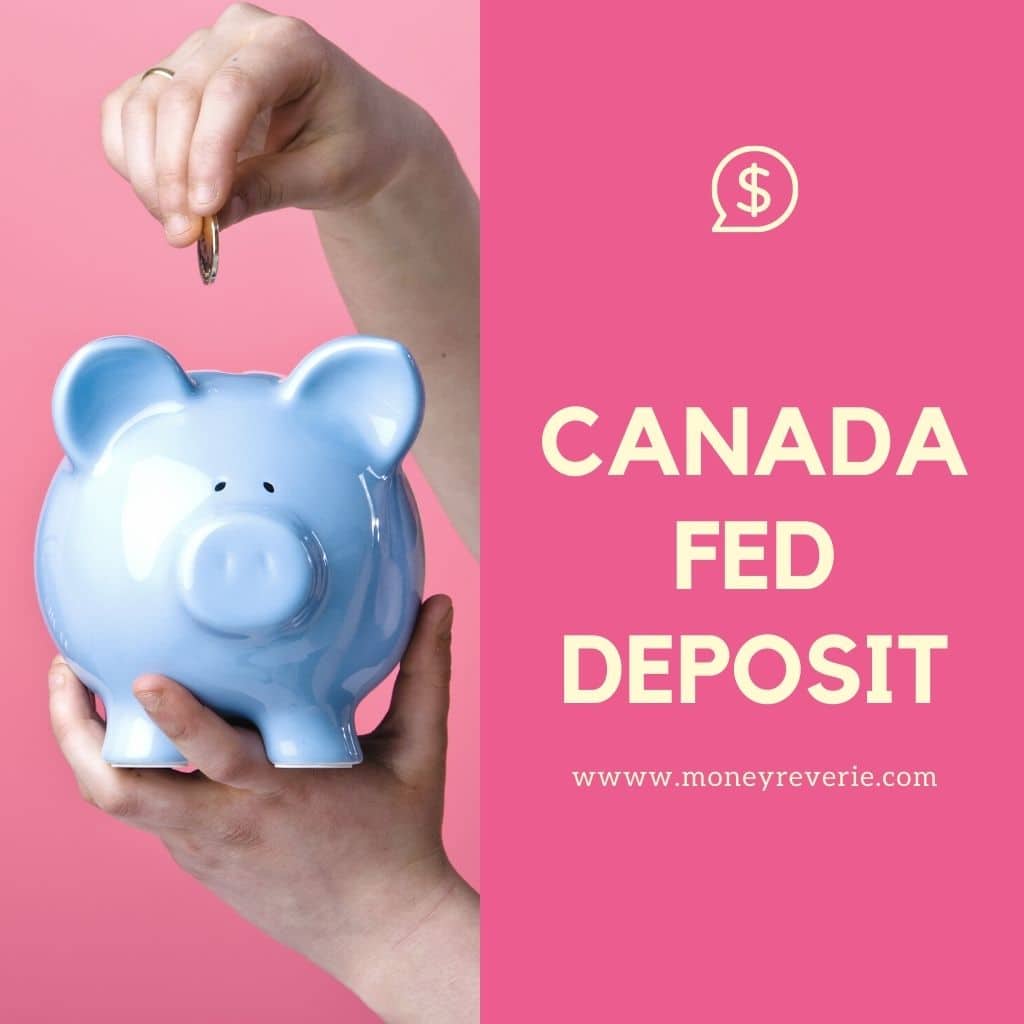The Canada Fed Deposit is a payment issued by the Canadian government through the Canada Revenue Agency (CRA), indicating that you are eligible for government benefits such as the Canada Child Benefit (CCB), GST/HST tax credit, Canada Workers Benefit (CWB), and more.
Each benefit has its own scheduled payment dates, and may be paid to your bank account under the label “Canada Fed”. When and how much you could receive depends on the program you are enrolled in and the payment dates of that benefit.
In this blog post, we will extensively discuss the Canada Fed deposit, how to qualify and apply for the Canada Fed payments, and other details like the Canada Fed payment dates for 2024.
Key Takeaways
- Government benefits like CCB, GST/HST tax credit, CWB, CAIP, etc., are labelled under Canada Fed.
- If you receive a deposit from CRA with the narration, “Canada Fed”, it means you have enrolled for a government benefit and are receiving payment for the benefit you are enrolled in.
- Canada fed deposit dates vary depending on the benefit program(s) you’re enrolled in.
- If you have direct deposit in your CRA MyAccount, your payments will be deposited directly into your account. Otherwise, you’ll receive a cheque by mail.
What is Canada Fed?
The label “Canada Fed” means that you have received payments from the Canadian government for some of its benefit programs. Receiving a Canada Fed deposit clearly indicates that you qualify for one or more of the following benefits:
- Canada Child Benefit (CCB)
- Goods and Services Tax (GST)/Harmonized Sales Tax (HST) credit
- Canada Workers Benefit (CWB)
- Child Disability Benefit (CDB)
- Climate Action Incentive Payment (CAIP)
Canada Fed Payment Dates for 2024
Your Canada Fed deposit dates will vary depending on the benefits or credits you are receiving. The Canada Fed dates for 2024 are as follows:
Canada Child Benefit (CCB) | GST/HST Credit | Canada Workers Benefit | Canada Child Disabilty Benefit | Climate Action Incentive Payment |
January 19, 2024 | January 5, 2024 | January 12, 2024 | January 19, 2024 | January 15, 2024 |
February 20, 2024 | April 5, 2024 | July 12, 2024 | February 20, 2024 | April 15, 2024 |
March 20, 2024 | July 5, 2024 | October 11, 2024 | March 20, 2024 | July 15, 2024 |
April 19, 2024 | October 4, 2024 | April 19, 2024 | October 15, 2024 | |
May 17, 2024 | May 17, 2024 | |||
June 20, 2024 | June 20, 2024 | |||
July 19, 2024 | July 19, 2024 | |||
August 20, 2024 | August 20, 2024 | |||
September 20, 2024 | September 20, 2024 | |||
October 18, 2024 | October 18, 2024 | |||
November 20, 2024 | November 20, 2024 | |||
December 13, 2024 | December 13, 2024 |
Canada Fed Payment Amount for 2024
How much Canada Fed Deposit you receive depends on the specific benefit that you are eligible for. Here are the payment amount for each benefit program under the Canada Fed.
Benefits | Maximum Benefit Amount |
Canada Child Benefits (CCB) | $538.08 for children under 6 |
Child Disability Benefit (CDB) | $248.75 for children under 18 |
GST/HST Tax Credit | $496 for single individuals |
Canada Workers Benefit (CWB) | $1,428 for single individuals |
Canada Carbon Rebate (CCR) | Varies by province |
Canada Fed Benefit Programs
Here are the programs listed under the Canada Fed Deposit:
1. Canada Child Benefit (CCB)
CCB is a federal government program designed to assist low-medium-income families in raising their children in Canada. This tax-free credit is paid to eligible Canadians with the “Canada CCB” or “Canada Fed”.
CCB payment dates for 2024 are:
- January 19, 2024
- February 20, 2024
- March 20, 2024
- April 19, 2024
- May 17, 2024
- June 20, 2024
- July 19, 2024
- August 20, 2024
- September 20, 2024
- October 18, 2024
- November 20, 2024
- December 13, 2024
How Much CCB Can You Receive?
If you have children below six, you could receive a CCB credit of up to $538.08 monthly or $6,997 annually, and if you have children between 6 and 17 years old, you could receive up to $491.91 monthly or $5,903 annually for each child.
However, how much you can get depends on your adjusted family net income for the previous tax year and the number of eligible kids you have.
The federal government of Canada introduced the Canada Child Benefit Young Child Supplement (CCBYCS) in 2021 to provide additional child benefits and support for eligible families. The final payment was made on October 29, 2021.
> Read more on CCB, eligibility, application, and entitlement.
2. GST/HST Credit
Goods and Services Tax (GST)/Harmonized Sales Tax (HST) is a quarterly tax-free credit to offset the sales taxes you pay when purchasing goods and services in Canada.
Like the CCB, GST/HST is also deposited by the CRA to low-medium-income Canadians. Depending on your province and territories of residence, you may also receive other provincial/territorial programs under the GST/HST deposit.
The GST/HST tax credit payment dates for 2024 are:
- January 5, 2024
- April 5, 2024
- July 5, 2024
- October 4, 2024
How Much GST/HST Credit Can You Receive?
The amount you receive as GST/HST tax credit depends on your family income, the number of registered children, and your previous tax return.
For the 2022 tax year, if you are single, you may receive up to $496; if you are married or have a common-law partner, you may receive up to $650 and $171 per eligible child under 19.
> Read more on GST/HST credit, eligibility, applications, and entitlement.
3. Canada Workers Benefit (CWB)
CWB is a benefit available to medium-low-income families and individuals in Canada. However, unlike CCB and GST/HST credit, the CWB is tax refundable. Therefore, you must file your tax return to be entitled to the CWB.
The CWB payment dates for 2024 are:
- January 12, 2024
- July 12, 2024
- October 11, 2024
How Much CWB Can You Receive?
You can benefit from a basic amount and a disability supplement. Single Canadians with adjusted net income below $23,495 can revive up to $1,428.
Families with an adjusted family net income below $26,805 can receive up to $2,461.
> Read more on Canada Workers Benefit (CWB)
4. Canada Child Disability Benefit
Families with children under 18 years living with a qualifying disability may receive child disability benefits from the government under the Canada Fed deposit.
The CDB payment dates for 2024 are:
- January 19, 2024
- February 20, 2024
- March 20, 2024
- April 19, 2024
- May 17, 2024
- June 20, 2024
- July 19, 2024
- August 20, 2024
- September 20, 2024
- October 18, 2024
- November 20, 2024
- December 13, 2024
How Much CDB Can You Receive?
You can get up to a maximum benefit of $248.75 monthly or $2,985 annually for each eligible child.
5. Climate Action Incentive Payments (CAIP)
The CAIP is a tax-free benefit paid to eligible families in Alberta, Ontario, Saskatchewan, and Manitoba to help offset the cost of the federal carbon tax.
If you reside in PEI, Newfoundland and Labrador, and Nova Scotia, you will be eligible for the federal fuel charge from July 1, 2023.
The CAIP payment dates are:
- January 15, 2024
- April 15, 2024
- July 15, 2024
- October 15, 2024
How Much CAIP Can You Receive?
The amount you can receive as CAIP benefits depends on your province of residence and your family size.
A family unit of four people can expect to receive the following as annual CAIP payments for the 2023-2024 payment period:
Family Member | Ontario | Manitoba | Saskatchewan | Alberta |
First adult | $488 | $528 | $680 | $772 |
Second adult | $244 | $264 | $340 | $386 |
Each child | $122 | $132 | $170 | $193 |
Family of 4 | $976 | $1,056 | $1,360 | $1,544 |
Who is Eligible for Canada Fed Payments?
To be eligible for Canada Fed deposits, you must meet the requirements of one of the programs under the Canada Fed.
To qualify for the CCB, you must:
- Be a Canadian resident
- Reach the age of majority in your province/territory
- Be responsible for raising your child
- Meet the income threshold
To qualify for the CDB, you must qualify for the CCB, and your child must be eligible for the Disability Tax Credit (DTC)
To qualify for the GST/HST tax credit, you must:
- Be a Canadian resident to file your income taxes
- Be above 19 years
- Have (or had) a spouse or common-law partner
- Be (or were) a parent and live (lived) with your child
To qualify for the CWB, you must:
- Be above 19 years of age
- Earn an employment income
- Be a Canadian resident for income tax purposes
To qualify for the CAIP, you must be a resident of Alberta, Ontario, Saskatchewan, or Manitoba on the first day of the payment month and the last day of the previous month.
Also, you must:
- Be above 19 years of age
- Have (or had) a spouse or common-law partner
- Be (were) a parent and live (lived) with your child
What is Canada Fed Deposit $900?
If you receive a payment notice from Canada Fed for $900 in your account, you must have likely applied for the Canada Recovery Benefit.
Though this benefit is closed, it was usually paid bi-weekly for $900. it was paid to those directly impacted by COVID-19 and unable to work.
What is Canada Fed Deposit $600?
If you receive a payment notice of $600, it signifies a one-time non-taxable disability payment from the Canadian government during the pandemic.
The payment was designed to cover any outstanding expenses from the pandemic. It is given to those who qualified for the DTC and previously received the Canada Pension Plan Disability (CPPD), Quebec Pension Plan Disability (QPPD), or the Veteran Affairs Canada (VAC).
You may also receive $600 if you are a senior. You can receive $300 as an Old Age Security (OAS) pension payment and $300 as a disability payment.
Also, you may have received a one-time $500 OAS and Guaranteed Income Supplement (GIS) and a $100 disability payment.
What is Canada Fed Deposit $450?
A $450 payment notice is likely a COVID-19 benefit payment. The Canada Recovery Caregiver Benefits (CRCB) and the Canada Recover Sickness Benefits (CRSB) are $500 weekly.
Though these benefits are now closed, they provided income support if you could not work due to sickness or stayed home with a child under 12 who was sick due to COVID-19.
What is Canada Fed Deposit $300?
If you receive a $300 payment notice, it is possible that it is a tax return payment or another benefit you applied for or were automatically approved for.
It is also possible that you have received a one-time COVID-19 benefit.
Why Did I Get Money From Deposit Canada?
You have received money because you qualify for the CCB, GST, or CWB benefits. After filing your taxes, the CRA assesses your financial situation and determines that you meet the eligibility criteria for one or more of these benefits.
Why Did I Get a Federal Payment Today?
If the federal payment you received today says “Canada fed” on your bank statement, then you’re likely receiving a payment for one of three things – Canada Child Benefit, a GST/HST payment, or the Canada Workers Benefit.
What is EFT Credit Canada?
Like Canada Fed, EFT credit Canada is another label on your bank statement indicating that you have received deposits from the federal government. So if you receive a Canada Fed deposit or EFT Credit Canada in your bank account, it simply means that you have qualified for one or more government benefits and are receiving payments for the programs you are enrolled in.
Is Canada Fed Deposit Taxable?
Canada Fed payments are non-taxable. However, you must file your tax return annually to receive the benefit, even if you haven’t earned a taxable income.
You can receive up to 50% of the Fed CWB payments in advance. The remainder can be claimed on your income tax return.
Final Thoughts on Canada Fed Deposit
Everyone knows how important it is to confirm the purpose of the deposit in your CRA MyAccount before spending it. So ensure you’re eligible for this Canada Fed payment, or else those few hundred or thousands of dollars may put you into a costly problem.
Even though you’re free to spend the money you want without bothering about taxes (except the CWB deposit), ensure to invest it in things that matter.
You can also check out other federal government deposits, such as Canada RIT and Canada Pro. Federal government deposits are free and can add up to building your long-term financial security.
So take the next step of confirming your eligibility and claiming all your entitlement benefits.
All the best!









